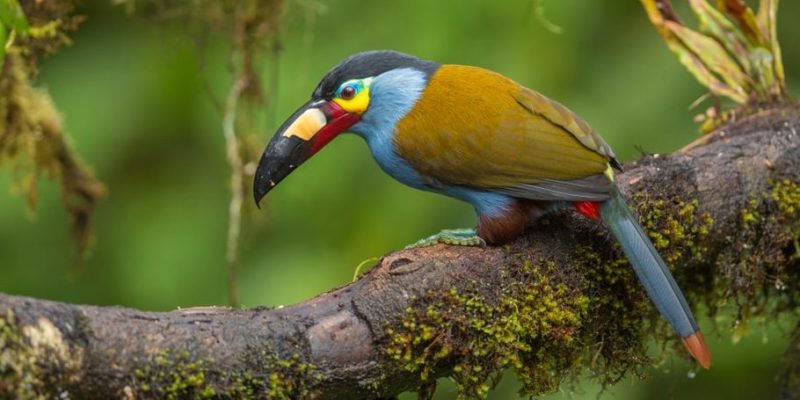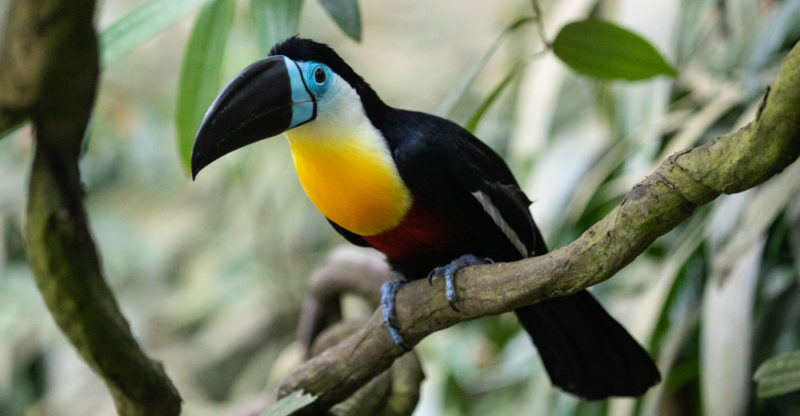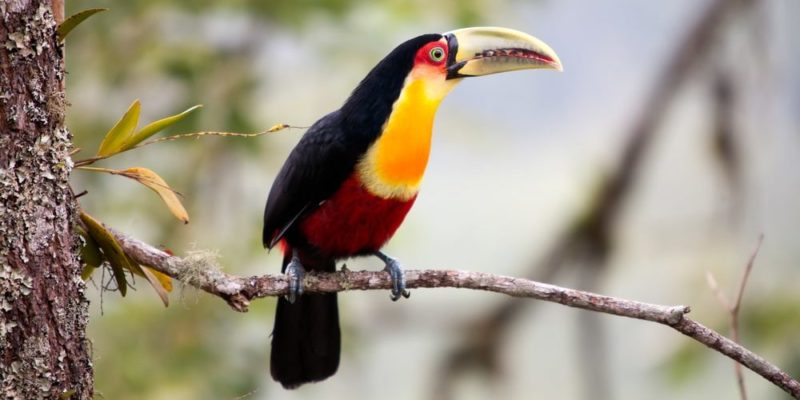We explain everything about the toucan, the types that exist and how they reproduce. In addition, what are its characteristics and feeding.
What is a toucan?
A family of birds is known as toucan, diotedé or diostedé . It is an extremely large family, which houses six genera and forty-two different species, all characterized by very long and voluminous beaks, and bright colors.
Toucans on average measure between 18 and 65 cm, weigh between 130 and 680 grams , and live about 20 years (18 in captivity). They are a monogamous species, holding the same partner for their entire lives. They do not have a melodious song, but a monotonous and at times unpleasant croak.
Toucan Habitat
Toucans are American birds , widely distributed from Mexico to Argentina .
They normally prefer low altitude tropical rain forests , although there are also species adapted to temperate forests at 3000 meters above sea level.
Their nests are usually in holes inside trees. It is a sedentary species , inhabiting the same region all its life.
Types of Toucans

Scholars of these birds generally classify them into two large groups:
- true toucans. Those that are properly toucans, that is, that have the conventional shape of a huge yellow beak, with colored spots on it and a body that tends to go from black and white to multicolor. Called ramphastos, they are larger and have a square tail.
- Arasaris. Much smaller than their cousins, they have a stepped, wedge-shaped tail, as well as fur that is usually green, red, and yellow.
Toucan Reproduction
The courtship of the toucans is very striking: the female and the male share food or sticks , with their bulky beaks. Their nests are usually in holes inside trees, and once fertilized, the female lays two to four white, oval, porous eggs in a single annual clutch.
The incubation of the eggs lasts between 17 and 20 days , after which the hatchlings come out devoid of plumage and with their eyes closed. After eight to nine weeks, they leave the nest to provide themselves with food and at three or four years they are sexually mature, ready to repeat the cycle.
Toucan Feeding

Toucans feed mostly on berries, seeds and ripe fruit , as they spend most of their lives in trees. However, they can also eat insects , small lizards, and even nestlings and the eggs of other birds .
They have a very small stomach. In captivity it is usual to feed them with caterpillars , insects or ground meat. To swallow they make a sudden movement with their neck, given the large size of their beaks.
toucan behavior
Toucans are very social birds . They usually walk in pairs or in small groups that can reach a dozen. They generally stay on the branches of trees.
In some places they are considered talkative birds , similar to parrots, but in reality they are not capable of repeating too many sounds . Its squawk can sometimes resemble a human voice .
They can be tamed, although they never lose their fierce and territorial nature , which requires keeping them in separate cages. The best thing, in any case, is to observe them in their natural habitat.
Toucan colors

The traditional toucan or toco toucan almost always has a body of well-differentiated black and white feathers , with a yellow and orange beak, at the end of which there is a black spot.
Other species have beaks with various colored spots , or they have a much more varied plumage, including shades of blue, yellow and green.
displacement of the toucan
Toucans do not fly for long periods of time . This may be due to the weight of their beak or because they simply do not have the need to do so, as they are not migratory birds.
Evolution of the toucan

Toucans are part of the endogenous American species that emerged from centuries of isolated evolution , once the continent moved away from the Euro-African mass until it reached its current position.
Within the world of birds, they are part of the order of the piciformes, seven families of birds with peculiar beaks . In this order are also the woodpeckers or bearded birds which, unlike the toucan, are found in Asia and Africa .
Its beak, the most striking physiological characteristic, reaches up to a third of its body . Not only does it serve as a tool for feeding , but it also provides an excellent cooling surface, which dissipates body heat and allows the animal to be kept cool in the high temperatures of the humid tropical forest.
State of conservation
The toucan is considered in danger of extinction , due to the confluence of different factors such as predation, hunting to make ornaments with its colorful feathers and beak. In addition, it is affected by the serious deforestation problem facing the Amazon.
Their threats also include biopiracy and captivity . For this reason, in many American countries today it is considered a crime to trade with these birds or to keep them in any type of captivity.
Main species of toucan

The main species of toucan are:
- Toco toucan ( Ramphastos toco ). The “classic” toucan, with a yellow beak turning orange and with a black spot at the end, as well as a black and white body that gives it an elegant appearance. They are endemic to South America and it is one of the largest known.
- Iris-billed toucan ( Ramphastos sulfuratus ). Inhabitant of the jungles of Mexico, Colombia and western Venezuela , on its body white is replaced by light yellow and its beak, on the other hand, has traces of different colors: red, green, blue, orange, in various reasons but generally horizontal.
- Chocó toucan ( Ramphastos brevis ). It is a toucan of the humid forests near the Pacific in Panama, Ecuador and western Colombia, in lowlands that do not exceed 1,000 meters above sea level. Its plumage is black with a yellow halo around its neck, and its bill shares these colors in a diagonal division.
- Two-colored toucan ( Ramphastos dicolorus ). Contrary to what its name indicates, it does not have only two colors, but three in the body: red, black and yellow, with some presence of white. But its beak, on the other hand, is a uniform gray color. It can be found in Bolivia , Paraguay , southeastern Brazil and northeastern Argentina.
She has pursued her studies in The United States, where she has graduated in Business and Economics and is currently finishing her Master studies in International Economics and Finance. Miss. Amputee is fluent in three languages: English, Spanish and Russian and has elementary knowledge of French and Italian. She love exploring how Collaborative Research Group can become the best tool to achieve the (necessary) educational change. .
Leave a reply
Your email address will not be published. Required fields are marked *Recent post

Sport: What Is It, Types, Risks, Features, Characteristics and Examples

Dogs: Emergence, Features, Characteristics, Feeding and Breeds

Story: Definition, Elements, Structure, Features and Characteristics

